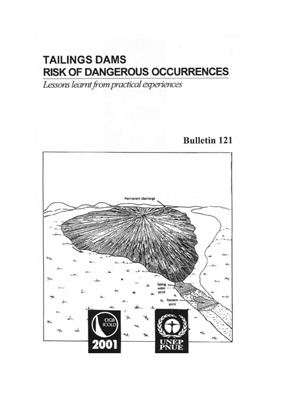British Sub - Committee on Tailings Dams, 2001, 145 pages.
The aim of this Bulletin (121) is to highlight and lea from some of the difficulties commonly encountered to help owners, managers, contractors and other personnel responsible for the day to day construction of tailings dams, to avoid similar difficulties. It is intended to be of help to all those connected in any way with tailings dams and waste lagoons: goverment officials conceed with regulations, planning offcials conceed about the requirements needed for planning permission, and those conceed about the continuing stability of existing tailings dams.
Examples are given of accidents and failures, together with some examples of effective remedial measures.
Table of contents:
Summary
Resume
Foreword
Preface
1. Introduction:
1.1. Objectives
1.2. Background
2. Pre-requisites for safe tailings dams
3. Overview of dam and tailings dam incidents
4. Common reasons for faulty behaviour
5. Risk management
5.1. Risk assessment
5.2. Risk management
5.3. Risk contigency plan
6. Lessons leat From this study
6.1. General assesment of the lessons leaed
6.2. Specific considerations with examples of incidents
6.2.1. Site selection and investigation
6.2.2. Starter dam
6.2.3. Unsatisfactory foundations
6.2.4. Lack of stability of the downstream slope
6.2.5. Superimposed loads
6.2.6. Problems with decants
6.2.7. Flow slides
6.2.8. Earthquakes
6.2.9. Ice and Fautly water balance
6.2.10. Impoundments not retained by a dam
6.3. Safety Management
7. Conclusions and recommendations
8. Lessons leaed: Implications for policy - a unep view
9. References
10. Figures
Appendix - Tailings Dams - Incident case records
1 - Introduction
2 - Abbreviations
3 - List of tailings dams for which incident cases were collected
4 - Brief descriptions of 221 cases
The aim of this Bulletin (121) is to highlight and lea from some of the difficulties commonly encountered to help owners, managers, contractors and other personnel responsible for the day to day construction of tailings dams, to avoid similar difficulties. It is intended to be of help to all those connected in any way with tailings dams and waste lagoons: goverment officials conceed with regulations, planning offcials conceed about the requirements needed for planning permission, and those conceed about the continuing stability of existing tailings dams.
Examples are given of accidents and failures, together with some examples of effective remedial measures.
Table of contents:
Summary
Resume
Foreword
Preface
1. Introduction:
1.1. Objectives
1.2. Background
2. Pre-requisites for safe tailings dams
3. Overview of dam and tailings dam incidents
4. Common reasons for faulty behaviour
5. Risk management
5.1. Risk assessment
5.2. Risk management
5.3. Risk contigency plan
6. Lessons leat From this study
6.1. General assesment of the lessons leaed
6.2. Specific considerations with examples of incidents
6.2.1. Site selection and investigation
6.2.2. Starter dam
6.2.3. Unsatisfactory foundations
6.2.4. Lack of stability of the downstream slope
6.2.5. Superimposed loads
6.2.6. Problems with decants
6.2.7. Flow slides
6.2.8. Earthquakes
6.2.9. Ice and Fautly water balance
6.2.10. Impoundments not retained by a dam
6.3. Safety Management
7. Conclusions and recommendations
8. Lessons leaed: Implications for policy - a unep view
9. References
10. Figures
Appendix - Tailings Dams - Incident case records
1 - Introduction
2 - Abbreviations
3 - List of tailings dams for which incident cases were collected
4 - Brief descriptions of 221 cases

